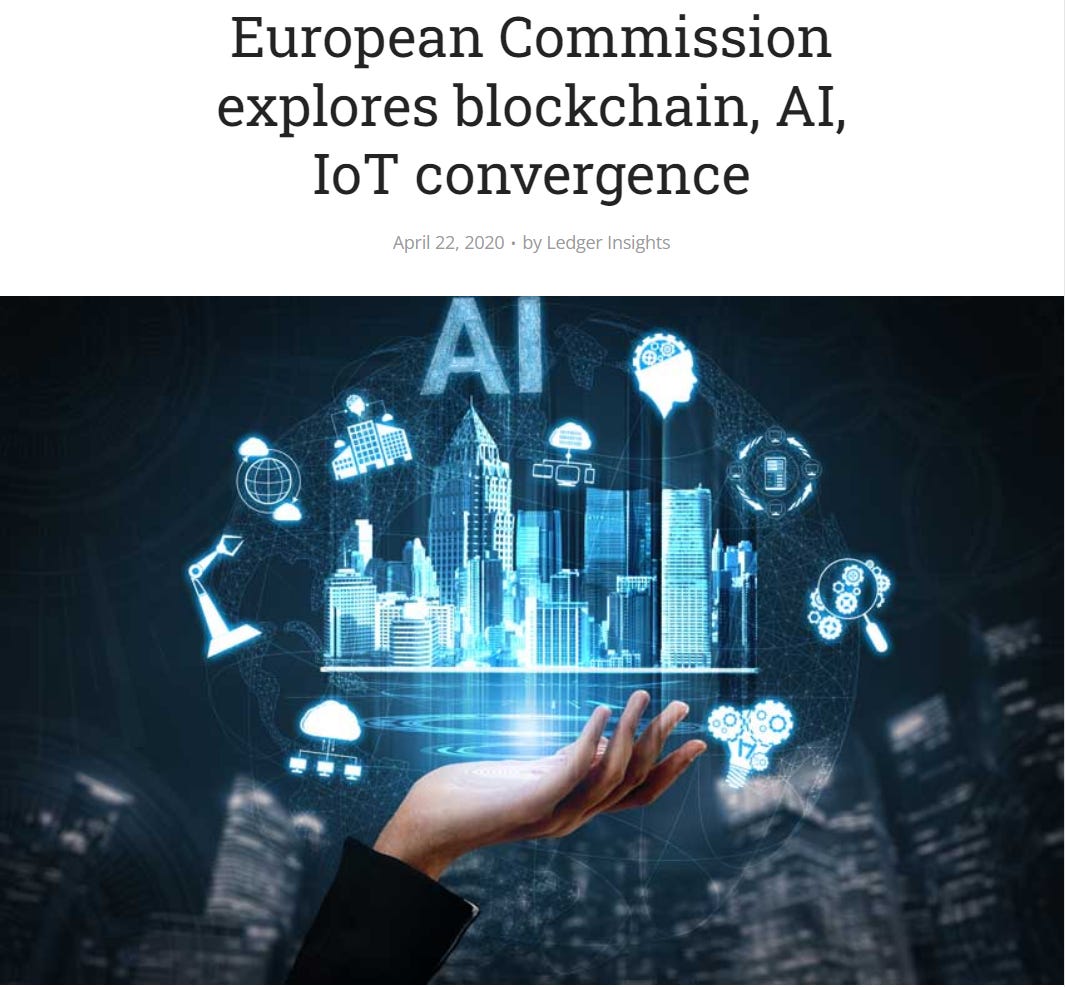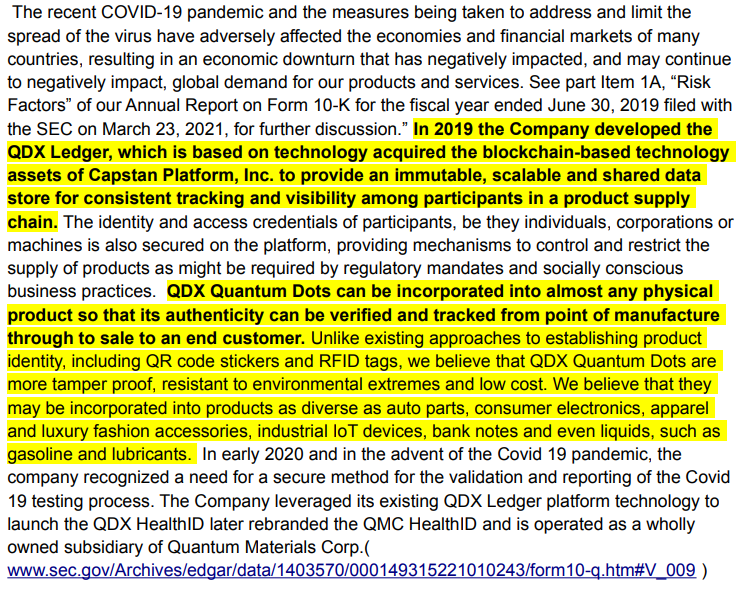Nano: Tiny, Yet So ... Toxic
REGARDING CBDC AND MASTERCARD Why is all this important?
Because, of course, this initiative was READY from the beginning, FROM THE START IT WAS ABOUT INSERTING NANOTECHNOLOGY:
https://www.ledgerinsights.com/nanotechnology-blockchain-covid-19-immunity-passports/
US firm combines nanotechnology, blockchain for COVID-19 immunity passports
April 15, 2020
U.S.-based quantum dot producer Quantum Materials Corp (QMC) announced its blockchain-based QDX HealthID for transparency in disease testing and immunization for infectious diseases. The goal is to ensure the authenticity of health data and support individuals to re-join the workforce quickly.
Quantum dots are nanoparticles made up of semiconductor materials that emit different colors when illuminated by light. This color depends on their size and the way they were manufactured. QMC has developed a track and trace solution using quantum dots and blockchain to verify the origin of products and counterfeiting.
The authentication solution is combined with QDX HealthID for monitoring and tracking the outbreaks of diseases, such as the COVID-19. The solution authenticates individuals being tested, the persons administering the test, and the test kits. Update: the COVID-19 solution uses the same authentication, but at this stage does not use quantum dots on packaging.
In simpler terms, QDX HealthID ensures that testing data is secure and not tampered with. Currently, health reports and medical certificates are being issued on paper, which makes them easy to forge.
“Not only does this service facilitate improved health outcomes for patients, but it also underpins back-to-work certifications, sometimes referred to as immunization passports,” said Stephen B. Squires, President & CEO of QMC.
With the health data backed by blockchain, governments and health agencies can formulate new plans and safety measures to contain the spread of COVID-19 and other diseases. Additionally, individual users can assess their immunization passport using a mobile application. The app features color-coded indicators — green, yellow, and red. If the app shows the green indicator, the individual has clearance to interact in social and work environments. This indicator can be shared and authenticated by others using a QR code.
“The world must have a system that eliminates the fears and anxiety of not knowing who is able to return to work,” said Les Paull, CEO of QMVT, the unit responsible for sales and marketing of QMC’s innovations.
The solution is hosted on the Microsoft Azure cloud and can integrate with existing EMR systems. It is based on the Hyperledger Sawtooth enterprise blockchain and for smart contracts, it’s using the Digital Asset Modeling Language (DAML).
Yesterday, Ledger Insights reported on the COVID Credentials initiative (CCI), which uses digital identity to develop “immunity passports”. Members of the initiative include Evernym, ID2020, uPort, Dutch research organization TNO, Microsoft, ConsenSys Health and consultants Luxoft and many others.
https://directorsblog.nih.gov/2020/11/05/speeding-covid-19-drug-discovery-with-quantum-dots/
Quantum dots, which have been around since the mid-1980s, are designed with special optical properties that allow them to fluoresce when exposed to ultraviolet light. The two pictured here are about 10 nanometers in diameter, about 3,000 times smaller than the width of a human hair. The quantum dot consists of a semi-conductive cadmium selenide inner core (orange) surrounded by a zinc sulfide outer shell (teal). Molecules on its surface (yellow) allow researchers to attach the viral spike protein (purple), which SARS-CoV-2 depends on to infect human cells.
What are Quantum Dots?
https://www.youtube.com/watch?v=LlPDyl53rZA
https://www.ledgerinsights.com/blockchain-ai-iot-convergence-european-commission/
The EU Blockchain Observatory and Forum recently published a whitepaper studying the use of blockchain alongside two other emerging technologies —the Internet of Things (IoT) and artificial intelligence (AI). The paper titled ‘Convergence of Blockchain, AI, and IoT’ explores benefits, current trends and challenges of combining the technologies for building new services and platforms.
Blockchain or decentralized ledger technology (DLT) enables the immutability of data, which is the need of the hour for IoT and AI. IoT devices generate data that needs to be securely shared among stakeholders. Meanwhile, AI systems require immutable data to function correctly. Blockchain can provide much-needed support for advancing these technologies and bringing them into the mainstream.
Blockchain and IoT
Convergence of technologies for smart cities
For its final study, the whitepaper discusses the use of blockchain, AI, and IoT for developing and managing smart cities. Smart cities are highly complex interconnected systems that combine different technologies for infrastructure services and social and economic systems.
The solutions could be linked together using blockchain, which would serve as an intermediary identity and authorization layer between IoT devices, like sensors, and AI-assisted infrastructure administration systems.
This could facilitate better management of waste disposal, peer to peer energy transactions, improve public transport, and local payment systems. On the other hand, healthcare and other public services could be provided efficiently to the residents of a smart city.
https://www.eublockchainforum.eu/sites/default/files/report_convergence_v1.0.pdf Smart cities: Convergence in action
They do not take into account the health issues. The fact that this technology is toxic and deadly, which we see all around us. They are just in denial "it wasn't caused by the 'vaccine'".
THAT'S WHY PEOPLE NEED TO BE HERDED INTO "SMART CITIES." That's where all the technology meets - the new "streetlamps," 5G and "climate change."
https://www.youtube.com/watch?v=h2ggB8Bcd4I
“Can blockchain help to combat fake news? Yes. In two ways…” [44:13]
https://www.sciencedirect.com/science/article/abs/pii/S0009279723000637
Quantum dots are time bomb:
Multiscale toxicological study - ScienceDirect
Volume 374, 1 April 2023, 110396
'We found that QDs had a dose-dependent species-specific toxic effect on animals. At doses greater than 30.0 mg/kg, mice died of spleen, kidney, and liver damage.’
Abstract
The use of quantum dots has spread widely into many applications. Works on the study of quantum dots on living organisms have had conflicting results on toxicity. There are no full-scale long-term toxicological studies with multiple administration of quantum dots. Understanding the toxicity of quantum dots is still limited. Here we present data on the effects of quantum dots on animals. In this work for the first time, it is shown that at a single administration of quantum dots in the body they have moderate species-specific toxicity, but repeated administration of quantum dots for 14 days even in the amount of 0.5 mg/kg leads to a delayed not completely irreversible hematotoxic effect, delayed irreversible disorders of barrier function of the liver, irreversible nephrotoxic effect, and to pathological changes in the thymus, kidneys and spleen. Administration of quantum dots in the amount of 2.5 mg/kg for 14 days leads to irreversible changes in the lungs, liver, spleen, kidneys and thyroid gland. This phenomenon is based on immunological reactions. On the one hand, these data confirm that quantum dots at a single administration can show relatively low toxicity. On the other hand, they cause to a delayed irreversible organ and tissue damage when repeatedly administered to the body even in small quantities. This study demonstrates that quantum dots are not as low in toxicity as previously thought to be and pose a serious risk when entering living organisms. Detecting and treating poisoning using standard methods of diagnosis and treatment of heavy metal poisoning may not be effective. This study demonstrates that toxic effects of quantum dots on a living body are quite complex and cannot be generalized based on previously reported assumptions.
(https://www.ledgerinsights.com/nanotechnology-blockchain-covid-19-immunity-passports/ US firm combines nanotechnology, blockchain for COVID-19 immunity passports - Ledger Insights - blockchain for enterprise)
https://www.sec.gov/Archives/edgar/data/1403570/000149315221010243/form10-q.htm#V_009
The Federal Drug Administration (“FDA”) has issued emergency use authorization (“EUA”) for medical tests that diagnose Covid-19.
“We have continued to maintain aggressive cost control measures, never forgetting this is a marathon and not a sprint. We are continuing to focus more resources on developing our continuous flow technology. We also have utilized investment funds to further develop our QDX Ledger anti-counterfeiting technology as well as related HeathID platform for pandemic and other diagnostic testing analysis, tracking and reporting. To further streamline our operations, we have continued to analyze our operating costs and make reductions whenever and wherever possible.
Recent Developments – COVID-19 pandemic
https://www.ledgerinsights.com/nanotechnology-blockchain-covid-19-immunity-passports/
TIME BOMB:
https://journals.sagepub.com/doi/full/10.1177/0748233718817180 An assessment of the cytotoxic effects of graphene nanoparticles on the epithelial cells of the human lung
THIS STUDY INDICATED THAT CYTOTOXICITY DEPENDS ON THE EXPOSURE PERIOD. GNPS WERE MORE CYTOTOXIC AFTER 72 H OF EXPOSURE COMPARED TO A 24-H AND 48-H EXPOSURE PERIOD. Chang et al. (2011) have reported similar results after 24, 48, and 72 h of exposure to GO and confirmed that the cytotoxicity of GNPs depends on the exposure period.
Hence, cytotoxicity was dose- and time-dependent.
Conclusion
The findings of the current study show that the viability of the A549 cells decrease with an increase in the concentration/dose of GNPs and the exposure period. In other words, the toxicological effects of GNPs on the A549 epithelial cells of the human lung are
dose- and time-dependent.
The NOAEC toxicological indicator for GNPs was 0.059 µg/mL. In addition to that, NOAEC may be related to the physicochemical properties of GNPs, the sample preparation, and the type of cell, which needs to be studied.
The results of this study can be helpful for development of the OEL for GNPs and risk evaluation of exposed population. However, more investigation is needed to clarify and specify the toxicological mechanisms of GNPs.









It's all coming together...however we only need one piece of the puzzle to be exposed, and the jenga game falls apart. I believe that once people understand how toxic EMFs have become, that this could be the key unlocking our freedom, but a basic understanding is necesssary: https://open.substack.com/pub/romanshapoval/p/emf101?r=1iykap&utm_campaign=post&utm_medium=web amazing work by the way, thank you.
Now I know why they have all those cartoons and Star Treks etc, to warm us up to, "The future will be so cool!".
Now let me tell you what this really is: a DOG COLLAR WITH 3 SWITCHES: Dementia, Pain, Kill.
Simple